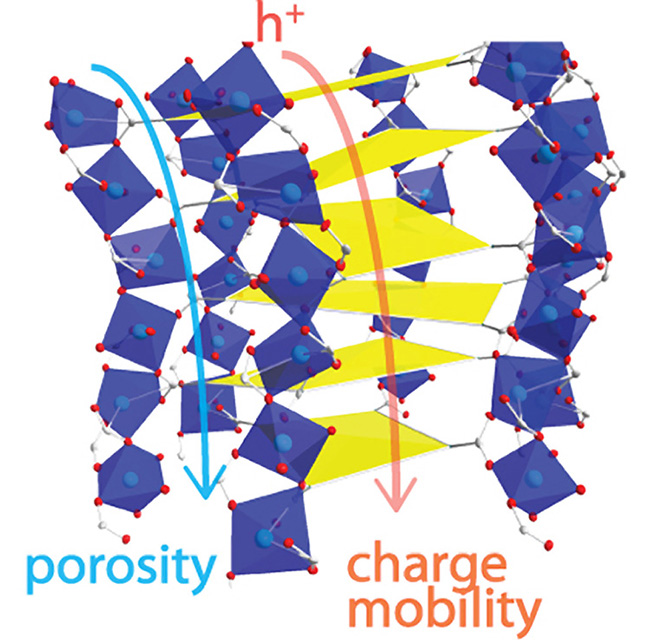Notorious Insulators Are Made Conductive
New porous, electrically conductive materials have potential uses in fuel cells, batteries, and solar photovoltaics.

The Science
Researchers have created an ordered columnar arrangement of complex organic molecules (modified tetrathiafulvalene) inside the crystalline structure of a microporous metal-organic framework (MOF); the overlap between the sulfur atoms within each organic molecule promoted charge transfer through the molecular stacks. The mobility of the charge carriers, in this case positively charged holes, was on par with that found in state-of-the-art organic semiconductors already used in organic photovoltaics and conductive polymers.
The Impact
High surface area conductive materials, such as microporous conductive ceramics, activated carbon, and porous semiconductors, have become important materials for new energy capture and storage technologies. Demonstrating the possibility of high charge mobility inside microporous MOFs for the first time is a big step towards enabling a new, highly versatile family of materials for improved fuel cells, batteries, supercapacitors, and photovoltaics.
Summary
Metal−organic frameworks (MOFs) are microporous materials made up at the molecular level of a lattice of metal ion and organic molecule building blocks. With very high intrinsic porosity and surface area, these materials have been developed for applications in gas separation and storage. Yet their very low electrical conductivity drastically impairs their utility as high surface area conductors in energy applications such as batteries, fuel cells, supercapacitors, or photovoltaics - the electrically inactive organic ligands normally do not provide a good electrical pathway. In a collaboration between MIT and Osaka University, researchers have for the first time synthesized a MOF that shows both stable micropores and good charge mobility. The key to the breakthrough was to use an organic molecule, tetrathiafulvalene (TTF), well known for contributing to electrical conductivity in charge transfer salts by forming stacked molecular columns. In the new TTF-based MOF material, a less-than-ideal TTF stacking sequence nevertheless displayed a high charge mobility, comparable to polythiophene materials widely used in organic photovoltaic devices. If the stacking overlap between neighboring TTF molecules can be improved, MOFs with even higher charge mobility may be possible.
Contact
Mircea Dincă
Massachusetts Institute of Technology
mdinca@mit.edu
Funding
Basic Research: DOE, Office of Science, Basic Energy Sciences program; the National Science Foundation supported instrumentation and MRSEC Shared Experimental Facilities; S.S. is supported by the Funding Program for Next-Generation World-Leading Researchers (NEXT Programs) of the Japan Society for the Promotion of Science.
Publications
Tarun C. Narayan, Tomoyo Miyakai, Shu Seki, and Mircea Dincă, High Charge Mobility in a Tetrathiafulvalene-based Microporous Metal Organic Framework., J. Am. Chem. Soc., 2012, 134 (31), 12932. [DOI: 10.1021/ja3059827]
Related Links
http://cen.acs.org/articles/90/web/2012/08/New-MOFs-Conductive.html
Highlight Categories
Performer: University
Additional: Collaborations , Non-DOE Interagency Collaboration , International Collaboration



